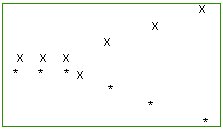COLLECTIVE SPORTS
UNIT: RUGBY
LESSON: 5/6
Aim:
INTRODUCTION OF THE SCRUMMAGE INTO THE GAME SITUATIONAPPARATUS: Rugby balls, cones/markers, coloured bibs
ORGANISATION
CONTENT
TEACHING POINTS
Number of players:
8 split into 4 pairs (for example; 2 blues, 2 yellows, 2 reds, 2 greens).
Round 1: blue and yellow versus red. Greens are scorers and timekeepers.
WARM UP: passing, tackling
• 4 on 2
On a signal to start, 4 attackers (for example 2 blues and 2 yellow) attempt to score a try by placing ball on ground over other team's ( red) end-line.
Ball carriers move forwards others get behind to receive backward pass only.
Defenders try to stop attacker from running with ball touching with two hands to his /her waist. Then, the player touched must stop and pass ball to team-mate and the game continues.
If try is scored or ball is dropped, or if the defenders gain hold of the ball, attackers have to begin again from the start line.
How many tries can attackers make in two minutes?
We need to take into account rotation of pairs to see if the correct pair plays one another.
Changes to the game:
Easier: make playing area wider, mark try-line closer –giving players more room to pass and run. Play a 4 v 1 game.
Working with a partner.
MAIN PART: Skills: Scrummaging
2- Scrum practice
Each player faces his/her partner on all fours (hands and knees on the ground).
Each player places his/her head to the left of his/her partner's and under his/her partner's right shoulder.
Head should fit in under shoulder and lock into place like a jiwsaw.
It is important that children lift head up whilst in this position.
Working in groups of 4.
P H P
X x x
3- Scrummaging
A-All children are divided in groups of 4. One acts as scrum half (SH). The other three act as forwards – two props (P) and a hooker (H) in the middle. The hooker binds around the two props (as in the diagram).
B- In the same groups of 4 as before, the scrum half puts the ball in, the hooker “strikes” the ball so that it goes between the left hand (loosehead) prop's legs.
Take it in turns to be:
• Scrum half
• Loose head prop (left hand prop) whose legs should be quite wide apart.
• Hooker who should have his/her feet close together pointing towards opposite right hand prop with most of his/her weight on the left foot. He/she “strikes” the ball when it is put in by the scrum half with the inside of his/her right foot.
• Tight head prop (right hand prop)
Work in groups of 8: 2 groups of 4.
C- 3 v 3 in scrum.
Now, two groups of 4 children work together. In each group of 4 there are the 2 props, the hooker (in the middle) and the scrum half.
The 2 groups are in scrum facing each other. They place their heads to the left and “bind”. The scrum half of one group put the ball in to his/her three. Children should keep their heads up.
They should follow the following rules:
1- No pushing is allowed.
2- The side putting the ball in are the only ones ahead to “hook” the ball. Only the hooker can strike for the ball.
3- The hook is not contested.
4- The feeding scrum half stands on the left of the scrum.
5- The ball is delivered by rolling it along the midline of the tunnel.
6- The non-feeding scrum half and all the other players stand behind their respective scrums in a position to run and pass the ball and do not move until the ball is back into the hands of the feeding scrum half. (It happens in a game situation, not in this activity).

GAME:
4- Game: 7 v 7
There are two teams of 7. Rules are as in 5 v 5 (see lesson 2) but now instead of a chicken scrum, use a 3 man scrum to restart the game when the ball is passed forwards/knocked forwards).